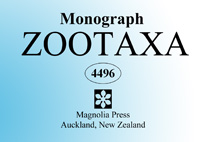Abstract
Four new species belonging to genera Amyntha and Metaphire were discovered from an extensive area in southern China, covering the provinces Sichuan, Yunnan, Guizhou, Guangdong, Guangxi, Fujian, Hunan, Jiangxi and Anhui. The species are named Amynthas dispersus Sun & Qiu, sp. nov., Amynthas shanghangensis Sun & Qiu, sp. nov., Amynthas dentiformis Sun & Jiang, sp. nov. and Metaphire sanmingensis Sun & Jiang, sp. nov. The first two new species have four pairs of intersegmental spermathecal pores in 5/6–8/9. A. dispersus has elliptical and glandular male pore porophores raised on a low pad-like area surrounded by two to three shallow skin folds, the genital papillae are variable in the spermathecal pore and male pore regions, and prostate glands are vestigial or rudimentary. Amynthas shanghangensis has male porophores surrounded by three papillae, each prostate gland accompanied by an accessory gland, and the distal ½–⅓ of the spermathecal diverticulum dilated into a rod-shaped seminal chamber. Amynthas dentiformis has two pairs of spermathecal pores in 7/8–8/9, male pores always surrounded by two papillae, and small sacs on the dorsal and ventral margins of the intestinal caecae; the prostate gland occasionally has stalked accessory glands. M. sanmingensis is in the Metaphire houlleti-group, and has secondary male pores opening to copulatory pouches, rod-shaped spermathecal seminal chamber, as well as variable genital papillae in spermathecal and male pores regions. The GenBank accession numbers of DNA barcode data are attached under the description of each species.
References
Blakemore, R.J. (2007) Updated checklist of pheretimoids (Oligochaeta: Megascolecidae: Pheretima auct) taxa. Cited 2017 May 23. Available from: http://www.annelida.net/earthworm/Pheretimoids.pdf (accessed 1 August 2018)
Blakemore, R.J. (2009) Chpater 14. Cosmopolitan earthworms—a global and historical perspective. In: Shain, D.H. (Ed.), Annelids in Modern Biology. John Wiley & Sons, Inc., New York, pp. 257–283.
https://doi.org/10.1002/9780470455203.ch14Chang, C.-H., Shen, H.-P. & Chen, J.-H. (2009) Earthworm fauna of Taiwan. National Taiwan University Press, Taipei, 174 pp.
Chen, Y. (1935) On a small collection of earthworms from Hongkong. Bulletin of the Fan Memorial Institute of Biology, Peiping, 6, 33–56.
Chen, Y. (1938) Oligochaeta from Hainan, Kwangtung. Contributions from the Biological Laboratory of the Science Society of China, Zoology, 12, 375–427.
Chen, Y. (1946) On the terrestrial Oligochaeta from Szechuan, iii. West China Border Research Society, Series B, 16, 83–141.
Chen, Y., Hsu, C., Yang, T. & Fong, H. (1975) On some new earthworms from China. Acta Zoologica Sinica, 21, 89–99.
Feng, X. (1984) A new subspecies of terrestrial Oligochaeta from Lanzhou, Kansu province. Zoological Research, 5, 47–50. [in Chinese]
Gates, G.E. (1972) Burmese earthworms: An introduction to the systematics and biology of megadrile oligochaetes with special reference to southeast Asia. Transactions of the American Philosophical Society, 62, 1–326.
https://doi.org/10.2307/1006214Goto, S. & Hatai, S. (1899) New or imperfectly known species of earthworms. No. 2. Annotations Zoologicae Japonensis, 3, 13–24.
Hong, Y. & James, S.W. (2001) Five new earthworms of the genus Amynthas Kinberg (Megascolecidae) with four pairs of spermathecae. Zoological Studies, 40, 269–275.
Hong, Y. & Kim, T.-H. (2002) Four new earthworms of the genus Amynthas (Oligochaeta: Megascolecidae) from Korea. Korean Journal of Biological Sciences, 6, 195–199.
https://doi.org/10.1080/12265071.2002.9647651Huang, J., Xu, Q., Sun, Z., Tang, G., Li, C. & Cui, C. (2007) Species abundance and zoogeographic affinities of Chinese terrestrial earthworms. European Journal of Soil Biology, 43, 33–38. [S33–S38.]
https://doi.org/10.1016/j.ejsobi.2007.08.036Jiang, J., Sun, J., Zhao, Q. & Qiu, J. (2014) Four new earthworm species of the genus Amynthas Kinberg (Oligochaeta: Megascolecidae) from the island of Hainan and Guangdong Province, China. Journal of Natural History, 49, 1–17.
https://doi.org/10.1080/00222933.2014.931480Qiu, J. & Zhong, Y. (1993) Notes on a new species and a new subspecies of the genus Metaphire from Guizhou Province, China. Guizhou Science, 11, 38–44. [in Chinese]
Sims, R. & Easton, E. (1972) A numerical revision of the earthworm genus Pheretima auct.(Megascolecidae: Oligochaeta) with the recognition of new genera and an appendix on the earthworms collected by the Royal Society North Borneo Expedition. Biological Journal of the Linnean Society, 4, 169–268.
https://doi.org/10.1111/j.1095-8312.1972.tb00694.xSun, J., Jiang, J., Hu, F. & Qiu, J. (2016) Four new earthworms of the genus Amynthas (Oligochaeta: Megascolecidae) from Mount Emei, Sichuan Province, China. Journal of Natural History, 50, 2499–2513.
https://doi.org/10.1080/00222933.2016.1193649Sun, J., Jiang, J. & Qiu, J. (2012) Four new species of the Amynthas corticis-group (Oligochaeta: Megascolecidae) from Hainan Island, China. Zootaxa, 3458, 149–158.
Sun, J., Jiang, J., Zhao, Q. & Qiu, J. (2015) New earthworms of the Amynthas morrisi-group (Oligochaeta, Megascolecidae) from Hainan Island, China. Zootaxa, 4058 (2), 257–266.
https://doi.org/10.11646/zootaxa.4058.2.7Sun, J., Zhao, Q., Jiang, J. & Qiu, J. (2013) New Amynthas species (Oligochaeta: Megascolecidae) from south and central Hainan Island, China and estimates of evolutionary divergence among some corticis-group species. Journal of Natural History, 47 (1–18), 1143–1160.
Sun, J., Zhao, Q. & Qiu, J. (2009) Four new species of earthworms belonging to the genus Amynthas (Oligochaeta: Megascolecidae) from Diaoluo Mountain, Hainan Island, China. Revue Suisse De Zoologie, 116, 289–301.
https://doi.org/10.5962/bhl.part.79497Sun, J., Zhao, Q. & Qiu, J. (2010) Three new species of earthworms belonging to the genus Amynthas (Oligochaeta: Megascolecidae) from Hainan Island, China. Zootaxa, 2680, 26–32.
Tsai, C.F., Shen, H.P., Tsai, S.C. & Lee, H.H. (2007) Four new species of terrestrial earthworms belonging to the genus Amynthas (Megascolecidae : Oligochaeta) from Taiwan with discussion on speculative synonyms and species delimitation in oligochaete taxonomy. Journal of Natural History, 41, 357–379.
https://doi.org/10.1080/00222930701201279Zhao, Q., Cluzeau, D., Briard, C., Sun, J., Jiang, J., Guernion, M. & Qiu, J. (2012) Hainan earthworm community and the comparison with other East and Southeast Asia countries for geographic distribution and endemic rate (Oligochaeta). Zoology in the Middle East, 58 (Supplement 4), 141–150.
https://doi.org/10.1080/09397140.2012.10648996Zhao, Q., Sun, J., Jiang, J. & Qiu, J. (2013) Four new species of genus Amynthas (Oligochaeta, Megascolecidae) from Hainan Island, China. Journal of Natural History, 47, 2175–2192.
https://doi.org/10.1080/00222933.2013.775374Zhao, Q., Sun, J. & Qiu, J. (2009) Three new species of the Amynthas hawayanus-group (Oligochaeta: Megascolecidae) from Hainan Island, China. Journal of Natural History, 43, 1027–1041.
https://doi.org/10.1080/00222930902767433

